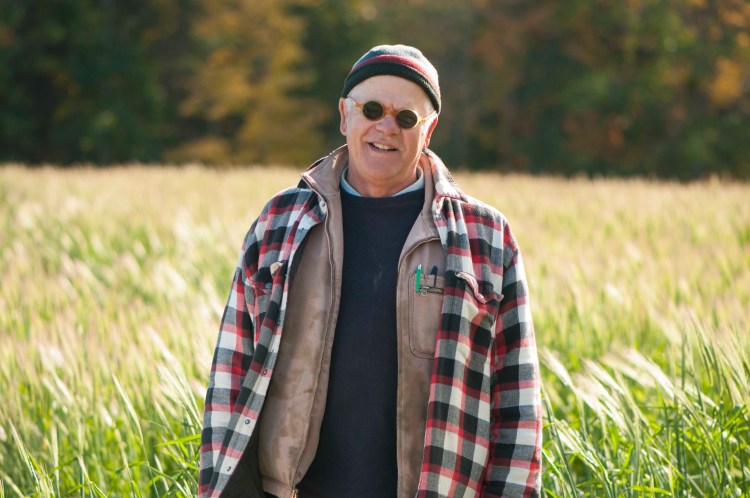Eero Ruuttila became the research station manager at Johnny’s Selected Seeds in October. We called the sustainable agriculture expert to talk about his new(ish) job and ended up talking about how summer days at Allen Ginsberg’s kitchen table helped inspire his farming career, what kinds of nightmares farmers have and whether a longtime farmer still learns new tricks of the trade decades into growing.
DOWN ON THE (SEED) FARM: “Let me walk out to the greenhouse,” Ruuttila says when we call. It’s January – what is Johnny’s growing? Tomatoes and peppers, which were planted in October and should be ready by February. Then their seeds will be replanted.
Johnny’s has nine plastic-covered growing structures, but only the one he’s walking through is heated and run through the winter. “It’s a way of speeding up time,” he said. “We gain a year in biological time.” He’s overseeing the health and well being of those plants and like so many of Johnny’s customers, drawing up the plans for the spring planting season.
MAP OF THE WORLD: Or more specifically, he and his colleagues are creating a map. “Every field is blocked out on a row-by-row basis. It’s a big blank slate.” Using GPS imagery, they create the map, then plug in information like soil formulation, any past disease issues and recent crops (for rotation issues). “We are starting to plug in the blanks.”
They grow plants in order to get seed to sell, but they also grow out seeds that they are purchasing or considering purchasing from others. Plantings of new varieties are in progress, too, as Johnny’s attempts to improve disease-resistance or other growing factors. “I have quite a palette of plants I am responsible for.” It isn’t Ruuttila’s job to evaluate the seeds but rather to nurture them to maturity.
ROOTS: By the way, his first name is pronounced like “arrow” and the name Ruuttila is Finnish. This is his 30th growing season. Before joining Johnny’s, he spent 22 years running Nesenkeag Farm, a 65-acre charitable and educational nonprofit in Litchfeld, New Hampshire. After shattering his shoulder while making a roof repair, he took some time to recover and moved to New Mexico, where he worked on Seeds of Change’s organic research farm.
He came back to New England and worked with the New Entry Sustainable Farming Project in Lowell, Massachusetts, and as a part-time University of Connecticut Extension agent. We’ve left out a few things, but with that kind of background, does he still learn new things? “Absolutely!” he said. Biology is always changing and every year is different, he added. “What I used to tell my student farmers is that there is no place for arrogance on the farm.”
He’s happy to get tips from his peers, no matter how much more experience he might have. “I am always open to learning the tricks of other folks that are skillful growers.”
FIELD OF BAD DREAMS: Not that he’s perfect. “I have made probably every mistake that can be made,” he said. “They haunt me in my dreams. You have your farm nightmares.” Do these involve scarecrows? “For me it is about missing opportunities in timing. Not doing something when you should have done it. Maybe you plan to fix something but then maybe it rains and you missed the window. Or you plan to do something in a day or two and then that becomes four or five days and you lose control.”
He sees planting seeds as like planting alarm clocks; there is a timer ticking down on their needs, the soil conditions, all the factors that help a plant grow. “You have all these alarm clocks that are ringing. That’s kind of the complexity of it.” Very Salvador Dali; no wonder he has nightmares.
ZEN AND THE ART OF GARDEN MAINTENANCE: Ruuttila is originally from Springfield, Illinois, where he grew up as an elite cross country runner. A year abroad in Finland, visiting and living with his grandmother’s extended family, gave him a chance to get serious about running. (He’d go on 13-mile rambles. Daily.) He continued to run competitively until he wrecked his knee doing college cross country.
It stuck with him in a way, though. “I think what I learned there is the physical discipline.” That comes in handy when you’re farming all day long.
An English major with an interest in Asian art, he took a summer-long detour during college, studying at the Buddhist-inspired Naropa University in Boulder, Colorado. The school wasn’t accredited at that point (we’re talking about the ’70s) but the faculty included poets Allen Ginsberg and Anne Waldman. Ruuttila landed the gig of editing the school’s literary journal.
HAPPY HOWL: “Because I was editing this magazine, I spent a lot of time at Allen and Anne’s kitchen table.” Other poets would visit, and the young Ruuttila would hit them up for contributions. “I had a lot of one-on-one interactions with some pretty amazing poets.” Not the least of whom was Ginsberg, with his dazzling intellect. And penchant for farming; Ginsberg had of late been spending time living on a farm, East Hill, in upstate New York. What the poet had to say about organic agriculture definitely planted a seed for the young student.
Later influences included a botanist roommate in a group house in Massachusetts when Ruuttila was working as a wholesale food buyer for what was then known as the New England Federation of Cooperatives (now Northeast Cooperatives). “This is when I was vicariously farming,” Ruuttila said. Now he’s the real deal.
Send questions/comments to the editors.




Comments are no longer available on this story